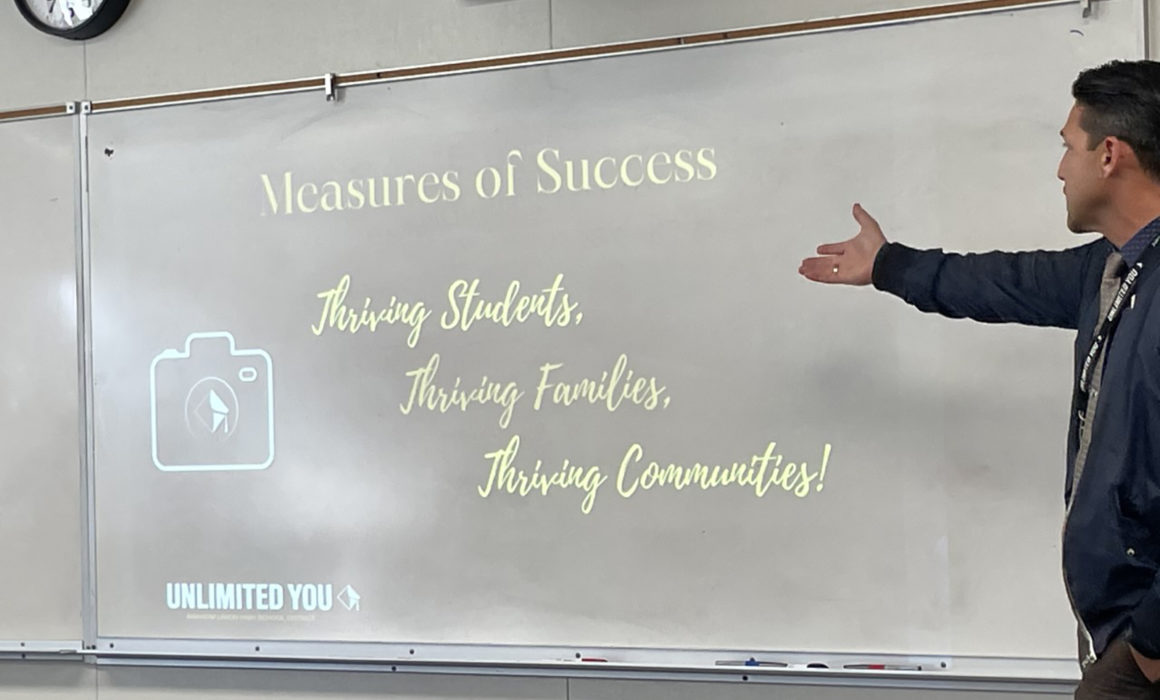
Local chapter hosts statewide leaders supporting the transformational model throughout the state.
California Teachers Association executive board members and Vice President David Goldberg met with Anaheim Secondary Teachers Association (ASTA) President Grant Shuster and local Anaheim Union High School District officials representing community schools in Anaheim. Adoption of a collaboration-driven model with deep community ties is making strides in meeting the needs of the whole child – while quietly transforming how we see our students and communities.
AUHSD’s model is a study in partnership. Local union leaders were foundational to the institution of the community schools model. Common values of the 13 schools are meant to replicate best practices to – building spaces and places for interaction encourages the replication of best practices, including collaboration and check-ins. This led the district to commit to a program that would include all 13 sites. ASTA President Grant Schuster explained the all-in approach their local took to ensure the program’s adoption throughout the district;
“Through the practices of shared leadership, engaging the community, providing integrated student supports and enriching student learning inside and outside of the classroom, we are focused to ensure the whole child and their family are supported to thrive. This process has more potential to transform public education than anything I have seen in my 30 years of teaching.”
Successful community schools are in constant contact with their students and parents to deeply understand the needs and assets of their school community. Through those interactions, community-based partners bring resources that help meet these needs in a dignified way that honors the hopes, dreams, and assets of our community. Sycamore’s school community works with North Orange Continuing Education to provide adult English as Second Language classes Monday through Thursday evenings; Healthy Smiles for Kids of Orange County to provide preventative and non-invasive dental care to students and dental health education to parents; Second Harvest Food Bank of Orange County to host a monthly, free farmers market, and Orange County Human Relations to embed restorative justice practices into all aspects of our school operations, from the classroom to the cafeteria, administration and beyond.
The community schools model adheres to overarching principles that invest in systems-not silos. Interventions are tailored to personal student needs, whether those challenges are social-emotional, food insecurity, language acquisition, special needs intervention, or need for other specialized family services. It is both microtargeting and delivery based on specific needs that makes the program a transformational one according to its proponents.
4 Pillars of Community Schools
- Integrated Student Supports
- Enriched and Expanded Learning Opportunities
- Family and Community Engagement
- Collaborative Leadership and Practices
Key to the success in Anaheim are the dedicated human resources that help coordinate the program’s many moving parts at each site. Community Schools Coordinators work side-by-side with site educators and support personnel, administrators, community partners, students and others on the daily facets of meeting diverse student needs. They are embedded in the local community and most are former students of the local school they serve.
“We’re looking to serve our children and our families holistically because we know they can’t leave who they are at the door. We want to make sure that we’re creating the conditions they need to thrive.”
–Araceli Huert, Sycamore’s Community School Coordinator
Coordinators manage the event calendar, direct parents and students to community services, operate on-site food pantries and secure local donations-among some of their responsibilities. They also co-lead school advisory committee meetings and keep all sides informed on matters of progress-and ongoing needs.
The other side of this critical partnership is the Community Schools Teacher Lead on each site. This relationship ensures that each site has trained, trauma-informed educators who are committed to developing trusting and collaborative relationships with students, families and community members. They encourage career pathway development with industry experts in and outside the classroom. Jemma Rodriguez, Teacher Lead at Sycamore JHS, believes that staff buy-in has been high because the model is making a difference; “Through the community school strategy, we are taking care of the whole child. For instance, a single student has received on-site services such as mental health counseling, holiday and winter clothing sponsorship through the school’s ‘Angel Tree’ and conflict mediation through restorative justice practices within the classroom. The same student’s family has also been referred to the resource center where they have received guidance and resource connections for legal matters and other basic needs, such as food and school uniforms.”
Another axiom in Anaheim is that community school programs should supplement, not supplant existing city services.
Ensuring that every program is a valued added measure makes for more abundant services and is not a means for justifying cuts and reductions. In this way, every site can maximize resources according to the needs determined at that site.
For AUHSD and the members of ASTA, this commitment to community schools is long-term. District officials see positive signs of progress as parents and students become reconnected to their local schools in the post-pandemic era. Confidence is strong among union members that this shared power model has the potential for transformational change throughout the public school system.
The Discussion 0 comments Post a Comment